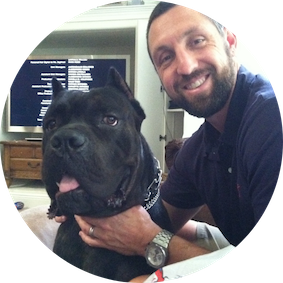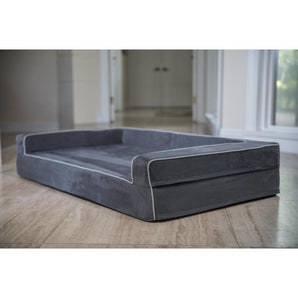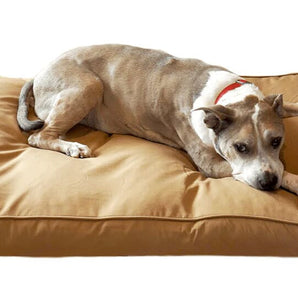Humans are not the only ones who experience anxiety. Dogs of all breeds and ages can feel it as well, and just like us, each canine manages this emotion differently.
It is fairly natural for anxiety to arise once in a while and should not be a cause for concern. However, canines can often develop a more intense form of anxiousness that, if not properly addressed with dog anxiety treatments, could lead to a serious disorder.
How to know if your dog’s anxiety is getting out of hand? How to calm an anxious dog down? Below we prepared a handy guide that explains all there is to know about how to help a dog with anxiety.
Dog Anxiety Symptoms
There are many clues to look out for in order to determine if your dog is experiencing anxiety, such as:
- Sudden aggression
- Destructive or compulsive behavior, especially around entry and exit points such as doors and windows.
- Excessive barking, even without triggers
- Constant pacing
- Excessive drooling and panting
- Restlessness and/ or trembling
- Decreased appetite
- Urinating or defecating indoors, even when housebroken
- Self-trauma such as excessive licking or chewing on their own fur and paws
Should you notice this in your dog, there is no need to be concerned outright as any of these symptoms can happen occasionally. The key is to catch it in the early stages of forming a pattern. The more frequently these happen, the better it is to address the situation straight away.
Dog Anxiety Causes
Anxiousness in dogs can stem from multiple triggers, but the top 3 most common ones are:
- Fear
- Separation
- Aging
Anxiety Due To Fear
Triggers for fear-related anxiety could be loud noises, strangers (both humans and animals), unfamiliar environments, new textures or surfaces (like grass or sand), or even situations from uncomfortable past experiences (such as car rides to the vet).
While fleeting reactions to these triggers are normal, significant and long-lasting reactions may be a symptom.
Anxiety Due To Separation
Separation anxiety affects a big population of canines. Dogs suffering from this disorder are restless and constantly worried when left alone or with unfamiliar people. The usual triggers that develop this disorder are if the dog has been abandoned, sent to a shelter or pound, has been adopted by a new family, or other abrupt changes in their social and personal life.
Anxiety Due To Aging
Older dogs sometimes suffer from CDS, or cognitive dysfunction syndrome. This disorder affects their memories, learning ability, perception, and awareness - quite similar to Alzheimer’s disease for humans. Because of all the mental strain this can cause, the dogs will tend to get very confused and anxious as a result.

Dog Anxiety Treatment
Learning how to calm an anxious dog can take a little practice and patience. They may not actively respond to your efforts right away but with time, they will soon find comfort in what you have to offer.
Because intense anxiety is usually caused by multiple factors, a combination of treatments can sometimes be more effective. There are multiple ways on how to help a dog with anxiety, most of which you can do at home. Here are a few suggestions to try out:
Consult With The Vet
One of the best ways to calm a dog down is by consulting a veterinarian. They are professionally trained to identify the kinds of anxiety your canine is experiencing, and with your help, the probable triggers that developed it. They are also able to determine any medical conditions that may or may not be causing your dog’s anxiousness.
Counterconditioning and Desensitization
Counterconditioning and desensitization is a form of training wherein you alter the dog’s perception of the trigger. One way to do this is exposing them to the trigger in a controlled and decreased intensity, and then having them associate it with a reward or something they love.
Mind Your Demeanor
Dogs have a heightened sense for emotions. When you feel restless and anxious, they can also mirror this and intensify their uneasiness. One way on how to stop dog anxiety is by controlling your own demeanor around them. Try not to give them too much attention, especially when you are leaving or just getting back home.
Exercise Your Dog
Anxiety can often bring about an excess of energy. By exercising your dog through playing fetch, going on a walk, or other physically demanding activities, you can tire them out and make them want to rest. At the same time, exercise also produces endorphins that relieve them of stress.
Physical Touch
Just as humans need hugs, dogs need our physical touch as well. Pick them up, cuddle with them, or at least regularly give a long and satisfying petting session.
Massage
In relation to physical touch, did you know that a massage is one of the best ways to calm a dog down and release any tension they have been holding? We suggest long strokes starting from the neck down. After some time, you may also be able to identify the stress areas your dog has and can focus on those more.
Classical Music
Studies show that classical music is beneficial to animals. It is powerful enough to relax them and can also lessen noise pollution from stressing sounds such as traffic or calls from other animals.
Toys
Toys can be mentally stimulating, entertaining, and can be good destressors. You can also use these as positive reinforcements for commendable behavior.
Orthopedic Calming Dog Beds
Finding the solution on how to stop dog anxiety can be as simple as getting them the right bed. One with orthopedic memory foam can ease tension, alleviate pain, and provide restful sleep – all of which can greatly lessen anxiousness and irritability in dogs both young and old.
Below are multiple dog beds featuring orthopedic memory foam that your anxious dog will love and appreciate!





